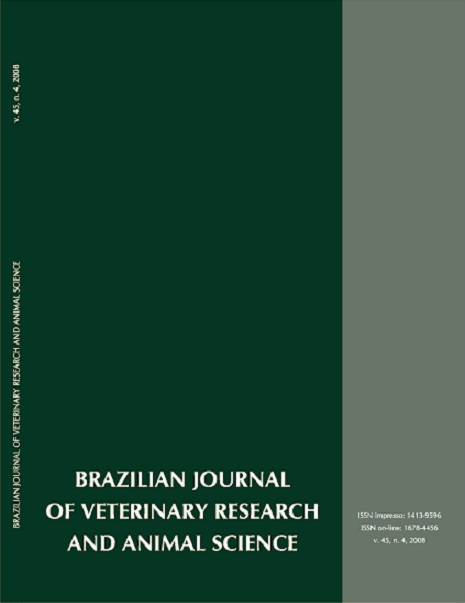Exoerythrocytic development of Plasmodium gallinaceum in primary fibroblast culture of chicken embryo
DOI:
https://doi.org/10.11606/issn.1678-4456.bjvras.2008.26683Keywords:
Avian malaria, Exoerythrocytic cycle, Fibroblast, In vitro cultureAbstract
In this study we assessed the susceptibility of primary fibroblast culture of chicken embryo to infection of P. gallinaceum sporozoites as well as the initial development of exoerithrocytic stages. Fibroblasts were obtained from the chest muscles of chicken embryos and sporozoites were obtained from experimentally infected Aedes fluviatilis salivary glands. After 1h, 3h, 24h, 48h and 72h periods pos-infection, cell cultures were fixed and analyzed both by indirect immunofluorescent-antibody test with anti-circumsporozoite protein monoclonal antibodies and by transmission electron microscopy. Circumsporozoite protein was detected in all parasitic forms. The mean percentage of fibroblasts with adhered or penetrated sporozoites did not significantly increase proportionately to the concentration of parasites in the inoculum, and independently if fetal calf or normal chicken sera were used in the culture medium. It was noted that the longer the incubation time, higher the possibility of the sporozoites to adhere and penetrate to fibroblats. Spozoites were observed penetrating in the fibroblast after 3h incubation when 0.68% of the cells had adhered parasites. Differentiation and development of the exoerythrocytic forms was observed after 24h incubation, when an average of 0,14% of the parasites have already invaded the cells. Developing parasites were found until 72h, when only 0.04% of fibroblasts were infected. Fibroblast cell culture seems to be a valuable experimental tool for in vitro investigation of the exoerytrocytic cycle of P. gallinaceum.Downloads
Download data is not yet available.
Downloads
Published
2008-08-01
Issue
Section
UNDEFINIED
License
The journal content is authorized under the Creative Commons BY-NC-SA license (summary of the license: https://
How to Cite
1.
Couto-Lima D, Lourenço-de-Oliveira R, Meirelles M de NL de, Porrozzi R. Exoerythrocytic development of Plasmodium gallinaceum in primary fibroblast culture of chicken embryo. Braz. J. Vet. Res. Anim. Sci. [Internet]. 2008 Aug. 1 [cited 2024 Apr. 17];45(4):255-6. Available from: https://revistas.usp.br/bjvras/article/view/26683





